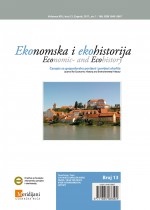UTJECAJ RIJEKE DRAVE NA NASELJA U ĐURĐEVEČKOJ PODRAVINI - PRIMJER SELA BROD U 18. I 19. STOLJEĆU
THE IMPACT OF THE RIVER DRAVA ON SETTLEMENTS IN ĐURĐEVEC AREA OF PODRAVINA – EXAMPLE OF VILLAGE BROD IN THE 18TH AND 19TH CENTURIES
Author(s): Nikola CikSubject(s): Geography, Regional studies, Energy and Environmental Studies, Physical Geopgraphy, Historical Geography, Environmental Geography, Recent History (1900 till today), Demography and human biology, 18th Century, 19th Century
Published by: Društvo za hrvatsku ekonomsku povijest i ekohistoriju - Izdavačka kuća Meridijani
Keywords: the Drava river; environmental history; demography; Brod; Đurđevec area of Podravina;
Summary/Abstract: The river Drava and its tributaries were in the past a very important geographic element in the Đurđevec area of Podravina because the floods restricted access to the banks of Drava and prevented settling in its vicinity. However, the great river had an attractive power for the people of Podravina, which is seen in the example of a ramified path networkt that led from all settlements in Đurđevec area of Podravina to the river Drava. The end points of such paths were river mills and crossings. This path network has affected environmental changes between the river Drava and the settlements located on the borders of the Đurđevečki peski (Đurđevec sands). A relatively wide zone of the forest-swamp area, partly meliorated and deforested during the 18th and 19th centuries, used to strech along the right bank of the river Drava. The process of deforestation and swamp draining, i.e. regulation of the tributaries of the Drava, was parallel to the process of occurence of konaki as temporary residences for humans and livestock. They originated in response to agrarian overcrowding in this part of Podravina in the second half of the 18th century. Konaki became independent villages in the 19th and 20th centuries, and because of the vicinity of the Drava, a specific coexistence with the river was developed there. The paper is focused on the village Brod, which was situated on the very bank of the river Drava during the 18th and first half of the 19th century and whose inhabitants have developed a specific coexistence with water through generations. We learn about life in Brod from various cartographic and written historical sources, especially from Parish register books with data for demographic research.
Journal: Ekonomska i ekohistorija - Časopis za gospodarsku povijest i povijest okoliša
- Issue Year: 2017
- Issue No: 13
- Page Range: 36-46
- Page Count: 11
- Language: Croatian

